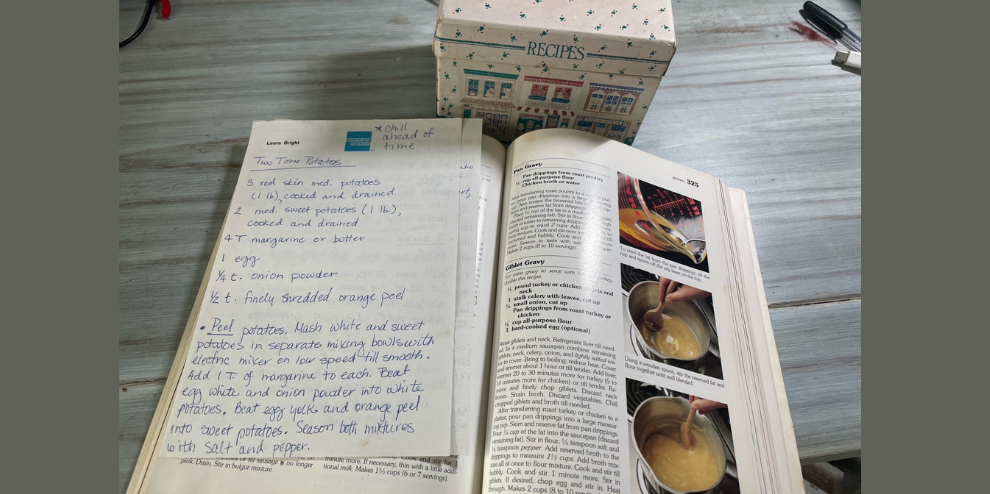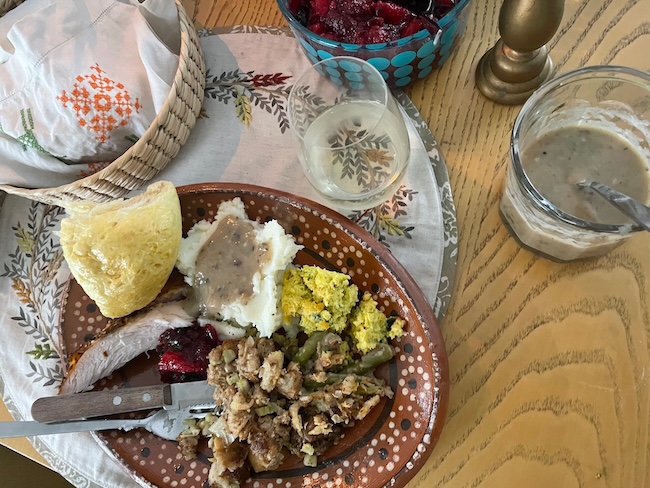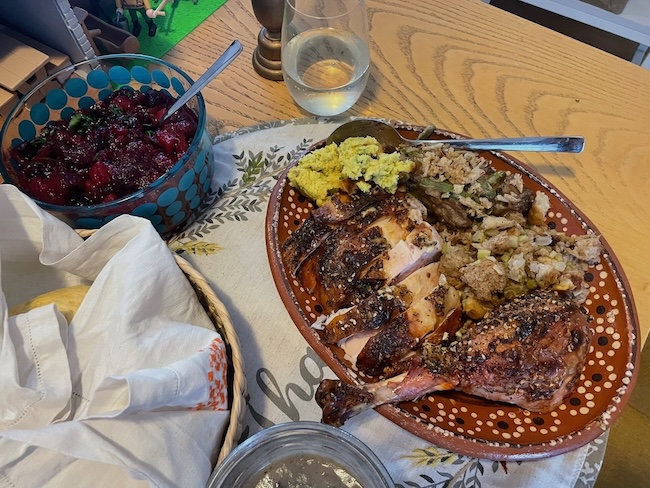Q&A with Laura Bright
Editor’s note: Nancy Cox is the founder of Research Story Consulting and former CPG corporate researcher. Her work and play include words, sketchpads, cooking (not baking) and the occasional sock puppet.
Research colleagues share their work and play stories in this interview series by Nancy Cox.
Hello to Laura Bright, independent researcher specializing in the Americas
What is the “play” in your life?
I really love to cook. When doing physical work, especially like kneading bread and baking things, I disconnect from everything else. There’s a phrase in Spanish about having your hands in the dough, “manos en la masa” similar to “roll your sleeves up” in the U.S. I like that physicality of cooking. My hands literally in the dough. Getting out of the work mode of just using my brain and getting to use my hands. That disconnect to me counts as play. Especially if I’m doing what I call “project cooking” and not cooking to feed myself, I get into flow.
Project cooking is challenging myself to learn a new skill. Can I make something from just seeing a picture without any instructions? One day, I decided to learn how to make bagels. It’s hard to get a good bagel in Mexico City. Taking time for this challenge is not a barrier for me. I’m not worried about the outcome in exchange for the time I’m putting in – it might not even turn out edible in the first few attempts. In the doing, I’m unwinding my mind. Ultimately, the bagels turned out pretty good. I had a lot of fun making a new batch of bagels every few days and using chopsticks – what I had – to make the hole. Real play in immersing myself and unraveling the stresses of my work.
Or project cooking can be the big production stuff. Thanksgiving for 20 to 60 people. My first dinner party ever that I hosted was Thanksgiving dinner. Go big or go home! Also, I wanted Thanksgiving and hosting it was the only way in Mexico to make sure I was going to have the full traditional Thanksgiving. Thanksgiving here in Mexico City is a lot harder. First, it’s not a holiday so we don’t get the day off. Also, we do not have all the traditional, regular ingredients. It’s a whole planning strategy. Starting in August, I ask people, “next time you go to the States for business, can you bring this back.” For example, if I want whole nutmeg, not ground, that has to be brought back from the States. We do get seasonal specialties like canned pumpkin, but you have to buy it when it hits the shelves. Canned pumpkin comes in at July and is sold out by September.
It also requires making almost everything from scratch. I can’t go out and buy a bag of Pepperidge Farms stuffing mix. I’m making the bread or cornbread. Then drying the bread cubes. Then making stuffing. There are no frozen piecrusts. You make the piecrust. For the turkey, you have to allow plucking time to finish cleaning the pins and feathers from the bird.
When I was in college, I cooked with very little resources. I kept my pantry under my bed. I had a plastic milk crate of cooking gear. On each floor of the dorm there was one mini fridge and a narrow oven that only fit loaf pans or 9” x 9” pans. One time when I was cooking a meal for a group, I used the oven on each floor, running up and down the floors. At Christmas, I made eight different types of Christmas cookies for everyone in the dorm.
Project cooking is not always a big party, it includes learning something new.
How has your play influenced your research work?
For both, I like the challenge of figuring things out. Breaking it down to key components. Making a strategy. More than my Thanksgiving dinners influencing my work, I think market research has made me a better dinner planner. I used to be more amateur about the dinners. Now? I’m at the spreadsheet level.
I have a master spreadsheet built over many years that is very important. The first tab is the menu. The menu has hot links to the actual recipes in the spreadsheet as well. The second tab is the grocery list organized by aisles and by different stores. Including the rolled-up quantities such as how much butter across all the recipes. A lot of butter. This tab also notes what I have on hand – do I already have walnuts or pecans in my freezer? Then I have my Thanksgiving week prep tabs – a Tuesday prep tab, Wednesday prep, Thanksgiving Day prep tab. Recipes are also hot linked on the prep tab pages. Also, in this master I have ideation tabs. So, when I’m menu planning with friends in early fall, we can see there are 12 possible starters, six potential soups, a seemingly endless choice of desserts. Then I make individual workbooks for each year’s Thanksgiving dinner.
Because I’ve done market research in Latin America for so long, I’ve embraced the creativity that is required working with limited resources and shifting priorities. I’m not as stressed that things just aren’t going to go as planned. For example, a few years ago I did my first kosher Thanksgiving dinner. Which meant choosing meat and no dairy. In someone else’s house, to use their kosher kitchen. This also meant I couldn’t use any of my tools nor could I pre-make anything in my house to bring.
Long story short, I didn’t understand that kosher margarine is very different than the margarine I’m used to. Had to adapt as that ingredient changed everything in terms of flavor and texture. The next kosher Thanksgiving I do, I will choose the dairy. I’d rather have the dinner without the turkey and be able to have all the luscious dairy. Also at that dinner, one of the desserts fell out of the refrigerator and smashed on the floor after I’d gone to all the trouble to make a non-dairy dessert that was holiday decadent. But I was OK. No one but me knew there wasn’t going to be this dessert. Cleaned it up off the floor and moved on. Just like in research.
My research industry experiences have also taught me to have fun along the way. This was a key takeaway from an industry seminar. Don’t wait until the end of the project and only celebrate the success of completion. Yes, it can be hard work. But you’ve got to have fun.
I combined that having fun and my love for both party and research projects in a big multidisciplinary effort. I needed the people in the manufacturing plant, the people on the floor to make this project work. I decided to have a kickoff party. Not wait until the end. A research project that starts with a party? No one had seen that before. This organization didn’t even do product launch parties. We had music. We had everyone in one room, and we talked about everyone’s role. Creating this amazing energy of “I want to do whatever I can to help this be successful.” Yes, we did all the operational research rigor but there was also room for excitement. At the very beginning! Don’t wait to have fun.
What would you tell readers who want to know more about your area of play?
I’m very much the Ina Garten philosophy of store-bought is fine. Figure out the parts you’d enjoy making – back to having fun along the way. Then for the rest outsource by buying or potluck. Do the parts that really matter to you. For many years, when I didn’t host Thanksgiving, I made a spectacular dessert. Also realize, even that spectacular dessert will get gobbled down. No matter how much time you put into that. The reward is that you enjoyed the making. The fun along the way.
Another fun part for me are the little rituals. One year I made a huge pot of butternut squash soup. I gave it to people in little espresso coffee cups outside – it’s lovely weather here in November – to get everyone mingling. Waking up their tastes with the ginger in the soup. A signal that this is not going to be exactly like Thanksgiving dinner back home. One time I started with a plated salad because it was a small enough party where we could all sit around one table. The person next to me started fussing that an arugula and pear salad was not part of Thanksgiving, why are we doing this? My response was that the whole idea was to bring us together at the table and say what we were grateful for. A time before everyone would disperse to go fill their plates. The point of the salad wasn’t to have some greens but to start together. After I explained that, she agreed it was a lovely idea.
If you’re not sure where to start, I began with my “Better Homes and Gardens Cookbook” then over the years built up my skills for more complex cooking. My first two Thanksgivings came out of that cookbook. Tucked in it, I still have my notes – TIP: keep your notes! – and I still go back to this book. You can have a fine meal starting with basic recipes, like the ones in this book. I started here and then added complexity over many years.
And I do believe in a good bourbon cocktail to start. Thanksgiving dinner, not research projects – although not a bad idea.


